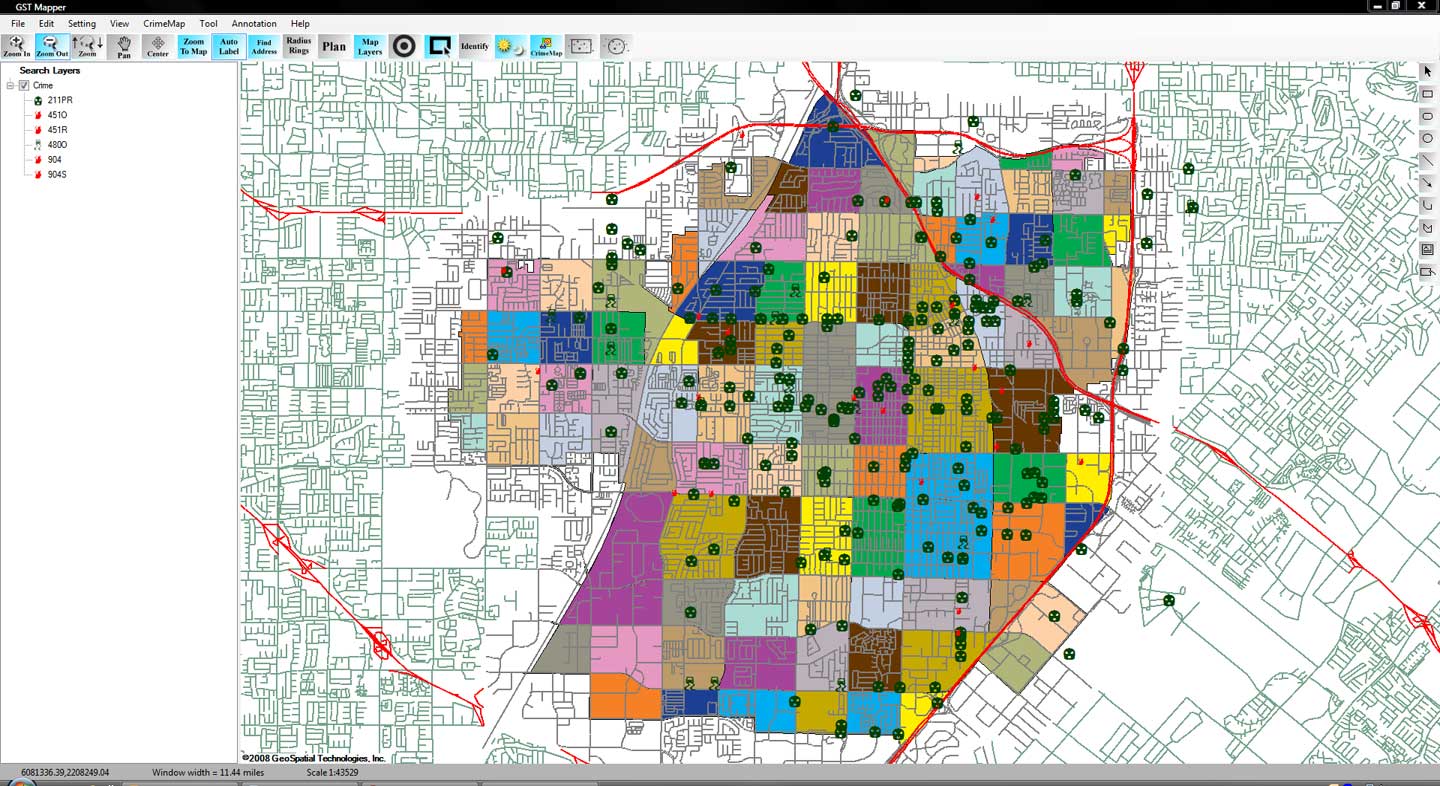Great article from PoliceMag.com, originally posted HERE.
 Since its introduction nearly a decade ago, big data in the form of analytics has helped police agencies all over the world enhance decision making, improve strategies to combat crime, and ultimately solve—and prevent—more crimes. But while the benefits of mining and critically analyzing huge amounts of data are being realized in other developed countries from the United Kingdom to Canada to New Zealand, U.S. law enforcement agencies have generally been slower to jump on the bandwagon.
Since its introduction nearly a decade ago, big data in the form of analytics has helped police agencies all over the world enhance decision making, improve strategies to combat crime, and ultimately solve—and prevent—more crimes. But while the benefits of mining and critically analyzing huge amounts of data are being realized in other developed countries from the United Kingdom to Canada to New Zealand, U.S. law enforcement agencies have generally been slower to jump on the bandwagon.
The reasons for slower adoption of big data tools in the United States are as varied as the nearly 18,000 state and local law enforcement agencies around the country. For many, the decision to buy or not to buy advanced crime analytics software often comes down to the usual culprit: lack of money. With few exceptions, police agencies across the country are faced with the prospect of doing more with less. And with increased pressure on local departments to put more feet on the street, do more in terms of community policing, and divert funding to equip all officers with body cams, it’s often hard for departments to make big data solutions a top priority.
Money, however, is not the only issue slowing analytics adoption in the U.S. Unlike countries such as the U.K., the American law enforcement community is decentralized. It does not have a single system of data, standards, and operations. Rather, police departments here pride themselves on their individuality and independence. Walk into a meeting where 10 different departments are represented and you will likely see 10 different colors of uniforms.
The same holds true when it comes to information sharing. While it is often assumed that police departments all work in close cooperation with each other, the reality may be quite different.
 None of this is news, nor is it a criticism of U.S. police departments. It simply reflects Americans’ independent nature and the way in which law enforcement in this country is structured. It’s the thing that makes us great but, in the case of analytics, it’s also a major factor slowing analytics adoption.
None of this is news, nor is it a criticism of U.S. police departments. It simply reflects Americans’ independent nature and the way in which law enforcement in this country is structured. It’s the thing that makes us great but, in the case of analytics, it’s also a major factor slowing analytics adoption.
Big data adoption is also hampered by the sheer size of the U.S. Sure, from a pure geographic standpoint, the U.S. and Canada are similar in size. But most of Canada’s people live in Ontario or on the West Coast, near Vancouver. There are just over 200 police departments in all of Canada. Compare that to the U.S., where there are huge differences in the make-up of the population, not to mention lifestyle, attitudes, and so much more between, say, the Southwest and the Northeast.
Law enforcement policy-makers on the East Coast don’t know what to make of their counterparts on the West Coast and vice versa. Similarly, the day-to-day needs and demands placed on a police chief in Kansas City can’t help but be very different from those of his or her peers in Chicago, Los Angeles, Seattle, or Philadelphia.
 All of these factors have contributed to slowing the adoption of analytics by U.S. police agencies. They are also complicated by perhaps the most intangible impediment: fear of technology. Whether they like to admit it or not, some law enforcement leaders are more comfortable taking an “old school” approach to police work. They prefer business as usual, which means feet on the street and files stacked on their detectives’ desks, not sleek, state-of-the-art technology.
All of these factors have contributed to slowing the adoption of analytics by U.S. police agencies. They are also complicated by perhaps the most intangible impediment: fear of technology. Whether they like to admit it or not, some law enforcement leaders are more comfortable taking an “old school” approach to police work. They prefer business as usual, which means feet on the street and files stacked on their detectives’ desks, not sleek, state-of-the-art technology.
Change is never easy, especially when tried-and-true policing methods have proven to be effective. Decentralization also plays a part here – it’s easier to take technology risks when it’s mandated from above and much harder for the nearly 18,000 law enforcement chiefs in the U.S. to each take a step into the unknown. Nevertheless, change is coming, spurred in large part by the fact that the cost of advanced crime analytics is coming down.
Also easing the impact of costs to local agencies will be the dollars for big data solutions coming from the federal government. Those funds come with a catch, however, that gets at another obstacle. A significant portion of federal funds in the future will be earmarked for supporting regional initiatives. That means to be eligible for federal funds, many departments will have no choice but to work with their colleagues across jurisdictional boundaries. And while that may bring some initial resistance, regional cooperation will inevitably help to promote not just data sharing, but overall effectiveness.
 The public is also demanding increased police effectiveness and efficiency. Responding to that pressure, police chiefs are recognizing that big data solutions can have a huge impact on reducing the number of man-hours it takes to sift through mountains of data in order to solve crimes. This is particularly important as law enforcement finds itself confronting not only the standard array of home break-ins, car thefts, and the like, but also the threat of “lone wolf” terrorist attacks, cybercrime, and highly sophisticated international trafficking rings.
The public is also demanding increased police effectiveness and efficiency. Responding to that pressure, police chiefs are recognizing that big data solutions can have a huge impact on reducing the number of man-hours it takes to sift through mountains of data in order to solve crimes. This is particularly important as law enforcement finds itself confronting not only the standard array of home break-ins, car thefts, and the like, but also the threat of “lone wolf” terrorist attacks, cybercrime, and highly sophisticated international trafficking rings.
Fortunately, as analytics software has become more affordable, it has also become easier to use. No longer the exclusive domain of the IT department, newer big data solutions are now designed to be used by front line analysts and investigators, with just one or two days of training and without the need for sophisticated oversight.
This has dramatically changed the role of law enforcement analysts. Formerly the department statistician, today’s analyst has become a critically important member of the crime fighting team, capable of rapidly moving from tactical analysis to the focal point of providing intelligence on high-profile crimes and strategic crime-fighting initiatives.
Ease of use also comes into play as a new generation of officers, many of whom were raised on Google and Xbox, begin to take on leadership roles in their departments. These individuals are used to having the latest technology at their immediate disposal. They will readily see that a big data solution can not only play a critical role in more effective policing, but also pay for itself in savings of both time and money.
 The growing use of cloud computing plays a role in this equation. Storing data in the cloud is becoming accepted as safe and secure, bringing with it economic advantages and removing the need for departments to provide highly specialized IT staff and infrastructure previously required to support analytical solutions.
The growing use of cloud computing plays a role in this equation. Storing data in the cloud is becoming accepted as safe and secure, bringing with it economic advantages and removing the need for departments to provide highly specialized IT staff and infrastructure previously required to support analytical solutions.
All of these factors are combining to change the face of effective policing in the U.S. That will mean significantly greater acceptance of analytics to mine everything from social media files, emails, text messages, and the content of police RMS systems to phone records, license plate reader data, and ballistics data. Efficiencies of scale will dictate greater cooperation among departments, resulting in increased efficiency and more effective policing. Being able to quickly search and find critical information in data that police agencies already have in hand will undoubtedly improve decision making and officer safety, while helping to solve cases more quickly.
 Crime Tech Solutions, who earlier this year acquired TN based Case Closed Software, delivers unique value to customers with comprehensive investigative case management software, sophisticated link analysis tools, criminal intelligence management software, and crime mapping technology that includes some of the industry’s best analytics and reporting capabilities.
Crime Tech Solutions, who earlier this year acquired TN based Case Closed Software, delivers unique value to customers with comprehensive investigative case management software, sophisticated link analysis tools, criminal intelligence management software, and crime mapping technology that includes some of the industry’s best analytics and reporting capabilities.
Tag Archives: Crime Tech Solutions
Overland Park senior crime analyst Jamie May joins Crime Tech Solutions
September 16, 2016 – (Leander, TX) Crime Tech Solutions, a fast-growing provider of low cost / high performance crime fighting software and analytics is delighted to announce the addition of Jamie May as senior analyst and strategic advisor to the company.
 Ms. May has spent over 17 years as a crime and intelligence analyst for Overland Park Police Department in Kansas, and is a recognized expert in crime analysis, mapping, and criminal intelligence. She has sat on critical crime analysis committees including the International Association of Crime Analysts’ Ethics Committee (IACA) and is a past Vice President / Secretary at Mid American Regional Crime Analyst Network (MARCAN).
Ms. May has spent over 17 years as a crime and intelligence analyst for Overland Park Police Department in Kansas, and is a recognized expert in crime analysis, mapping, and criminal intelligence. She has sat on critical crime analysis committees including the International Association of Crime Analysts’ Ethics Committee (IACA) and is a past Vice President / Secretary at Mid American Regional Crime Analyst Network (MARCAN).
“Jamie brings an incredible amount of user experience and innovation to the company”, said Kevin Konczal, Crime Tech Solutions’ VP of Sales. “She’s been active in this community for years, and co-authored the ground-breaking guide, GIS in Law Enforcement: Implementation Issues and Case Studies.”
“To me, Crime Tech Solutions represents a truly innovative company that understands how to develop and market very good technology at prices that most agencies can actually afford”, said Ms. May. “I’m looking forward to being part of the continued growth here.”
In her role with the company, Ms. May will interact with customers and prospects to help align the company’s solution strategy with market and user requirements.
 Crime Tech Solutions, who earlier this year acquired TN based Case Closed Software, delivers unique value to customers with comprehensive investigative case management software, sophisticated link analysis tools, criminal intelligence management software, and crime mapping technology that includes some of the industry’s best analytics and reporting capabilities.
Crime Tech Solutions, who earlier this year acquired TN based Case Closed Software, delivers unique value to customers with comprehensive investigative case management software, sophisticated link analysis tools, criminal intelligence management software, and crime mapping technology that includes some of the industry’s best analytics and reporting capabilities.
Using crime analysis solutions to take a ‘Byte’ out of crime
 Posted by Crime Tech Solutions
Posted by Crime Tech Solutions
Law enforcement agencies everywhere are tasked with reducing and investigating crime with fewer and fewer resources at their disposal. “To protect and serve” is the highest responsibilities one can sign up for, particularly in light of recent well-publicized criticisms of police by activists in every city.
That responsibility weighs even heavier in a world with no shortage of criminals and terrorists. There’s never enough money in the budget to adequately deal with all of the issues that face an individual agency on a daily basis. Never enough feet on the street, as they say.
New Tools for Age-Old Problems
Perhaps that’s why agencies everywhere are moving to fight crime with an evolving 21st century weapon – law enforcement software including investigative case management, link and social network analysis, and, importantly, crime analytics with geospatial and temporal mapping.

Crime analytics and investigation software have proven themselves to be valuable tools in thwarting criminal activity by helping to better define resource allocation, target investigations more accurately, and enhancing public safety,
According to some reports, law enforcement budgets have been reduced by over 80% since the early 2000s. Still, agencies are asked to do more and more, with less and less.
Analytics in Policing

Analytics in law enforcement play a key role in helping law enforcement agencies better forecast what types of crimes are most likely to occur in a certain area within a certain window of time. While no predictive analytics solution offers the clarity of a crystal ball, they can be effective in affecting crime reduction and public safety.
Predictive analysis, in essence, is taking data from disparate sources, analyzing them and then using the results to anticipate, prevent and respond more effectively to future crime. Those disparate data sources typically include historical crime data from records management systems, calls for service/dispatch information, tip lines, confidential informant information, and specialized criminal intelligence data.
The Five W’s of Predictive Analytics
Within this disparate data lie the 5 W’s of information that can be used by crime analysis software to build predictions. Those key pieces include:
- Arrest records – who committed crimes
- Geospatial data – where crimes have occurred
- Temporal data – when crimes have occurred
- Statistical data – what crimes have occurred
- Investigation data – why (and how) the crimes occurred

Using the 5 W’s, agencies are able to gain insight and make predictions about likely future criminal behavior. For example, if a certain type of crime (what) tends to occur in ‘this’ area (where) at ‘this’ time (when), and by ‘this’ type of individual (who) for ‘this’ reason (why)… it would be wise to deploy resources in that area at that time in order to prevent the incidents from ever occurring. This, of course, is a dramatic over-simplification of the types of analytics that make up predictive policing, but illustrates the general concept well.
Although criminals will always try to be one step ahead of the law, agencies deploying predictive analytics are able to maximize the effectiveness of its staff and other resources, increasing public safety, and keeping bad guys off the street.
More about Crime Tech Solutions
Crime Tech Solutions is an Austin, TX based provider of crime and fraud analytics software for commercial and law enforcement groups. Our offerings include sophisticated Case Closed™ investigative case management and major case management, GangBuster™ gang intelligence software, powerful link analysis software, evidence management, mobile applications for law enforcement, comprehensive crime analytics with mapping and temporal reporting, and 28 CFR Part 23 compliant criminal intelligence database management systems.
Crime Tech Solutions’ continued growth fuels management team expansion
September 13, 2016 – (Leander, TX) Crime Tech Solutions, a fast-growing provider of low cost crime fighting software and analytics today announced the appointment of Kevin Konczal as Vice President of Sales. The company created the position in response to rapid growth in market share for crime analysis and investigative case management software.
 Mr. Konczal is a seasoned start-up and marketing expert with over 30 years of diversified business management, marketing and start-up experience in information technology and consumer goods. Additionally, Konczal has over two decades of Public Safety service as a police officer, Deputy Sheriff and Special Agent.
Mr. Konczal is a seasoned start-up and marketing expert with over 30 years of diversified business management, marketing and start-up experience in information technology and consumer goods. Additionally, Konczal has over two decades of Public Safety service as a police officer, Deputy Sheriff and Special Agent.
Most recently, he held the position as a Regional Sales Manager for TriTech Software Systems, a leading provider of public safety software.
“Kevin is a seasoned executive with a combination of public service and information technology expertise”, said Crime Tech Solutions’ chief technology officer Keith Weigand. “The management team is looking forward to adding his leadership within the sales organization.”
In addition to his executive career, Konczal serves on several advisory boards, commissions and boards of directors. He attended Oakland College studying Criminal Justice and completed the Dallas Police Academy. Notably, he was awarded the Police Commendation Award for saving the lives of fellow officers in a deadly force c onfrontation.
onfrontation.
“The exciting thing about Crime Tech Solutions”, added Konczal “is their clear position as a fast-growing company dedicated to low price and high performance software for law enforcement.”
“I’m looking forward to working with a company that delivers true value to customers with comprehensive investigative case management software, sophisticated link analysis tools, criminal intelligence management software, and crime mapping technology that includes what I think are the industry’s best analytics and reporting capabilities”, he added.
Earlier this year, Crime Tech Solutions acquired Tennessee based Case Closed Software (www.caseclosedsoftware.com).
About Crime Tech Solutions
Crime Tech Solutions (www.crimetechsolutions.com) is a fast-growing U.S. based provider of low cost / high performance investigation software and crime analytics. The company proudly supports the International Association of Crime Analysts (www.iaca.net), International Association of Chiefs of Police (www.iacp.org), the National Sheriff’s Association (www.sheriffs.org), and the association of Law Enforcement Intelligence Units (www.leiu.org).
The company’s products include Case Closed investigative case management software, link and social network analytics, 28 CFR Part 23 compliant criminal intelligence management software, enterprise search for law enforcement, and crime analytics with mapping, reporting, and predictive policing.
Crime Hot Spots and Risk Terrain Modeling

By Tyler Wood, Operations Manager at Crime Tech Solutions.
One of the many functions crime analysis performs is the identification of “hot spots”, or geographical areas that seem to be hubs for criminal activity. Identifying these hot spots through best practices in geospatial crime mapping allows law enforcement to focus their efforts in areas that need them most. The trouble that law enforcement and crime analysts have encountered is displacement – the fact that once a hot spot is “cleared”, crime seems to pop up again in a different location. The good news is that the displacement is never 100%, so policing hot spots is important – it’s just not a magic bullet.
To solve this problem, a team at Rutgers University’s School of Criminal Justice set out to develop new methodologies that would result in peaceful outcomes that are built to last instead of merely temporary.
The difference between the old approach and the new approach is stark. Where police and analysts used to focus solely on geographical concentration of crimes, Risk Terrain Modeling examines the factors that contribute to such dense concentrations to begin with. Rutgers team have identified several characteristics of any given geographical location which may attract or generate crime. Their technology takes these characteristics, which include socioeconomic data, physical layout, types of local businesses, etc… and uses them to calculate the likelihood crime occurring in the area. This allows law enforcement to be proactive in the prevention of crime in these areas.

The technique seems to be highly effective. After a trial run in New Haven, CT, police were able to identify sixteen “statistically significant risk factors that underlie violent crime occurrences.” A high percentage of violent crime in New Haven during the test period occurred in locations already identified by the concept of risk terrain modeling. Though the technology is still new, it is clearly showing impressive results already.
Shutting down hot spots is important policing, and risk terrain modeling technology allows analysts and law enforcement officers to be even more proactive in their prevention of crime.
The author, Tyler Wood, is head of operations at Austin, TX based Crime Tech Solutions – an innovator in crime analytics and law enforcement crime-fighting software. The clear price/performance leader for crime fighting software, the company’s offerings include sophisticated Case Closed™ investigative case management and major case management, GangBuster™ gang intelligence software, powerful link analysis software, evidence management, mobile applications for law enforcement, comprehensive crime analytics with mapping and predictive policing, and 28 CFR Part 23 compliant criminal intelligence database management systems.)
Crime Tech Solutions Acquires Case Closed Software
June 1, 2016 (Austin, TX) Crime Tech Solutions, LLC, a leading provider of analytics and investigation software for law enforcement and commercial markets, today announced that it has acquired Cleveland, TN based Case Closed Software in a cash transaction. The terms of the deal were not released, but according to Crime Tech Solutions’ founder and president Douglas Wood, the acquisition brings together two dynamic and fast-growing software companies with an unparalleled complement of technologies.
“For Crime Tech Solutions, the opportunity to add Case Closed Software into the fold was too good to pass up” said Mr. Wood. “We think that the technology offered by Case Closed helps to further differentiate us in the market as the price performance leader for this type of investigative solution.”
Crime Tech Solutions, based in the city of Leander, TX, delivers advanced analytics and investigation software to commercial investigators and law enforcement agencies across the globe. Their solution suite includes criminal intelligence software, sophisticated crime analytics with geospatial mapping, and powerful link analysis and visualization software. The company says that the addition of Case Closed Software expands those offerings even further.
Case Closed Software develops and markets investigative case management software specifically designed for law enforcement agencies. The suite is built around four primary software products including best-in-class investigative case management software, property and evidence tracking, a gang database tool, and an integrated link analysis and data visualization tool. The company also plans to release the solution as Case Closed Cloud for cloud-based access.
“Case Closed couldn’t be happier than to be joining Crime Tech Solutions,” said Keith Weigand, the company’s founder. “The blending of our technologies creates a suite that will add tremendous value to our mutual customers, and will be hard for others to duplicate.”
According to both Mr. Weigand and Mr. Wood, the name Case Closed will continue on as the product brand, given its widespread popularity and loyal customer base. Crime Tech Solutions is expected to retain all Case Closed employees, with Mr. Weigand joining as the company’s chief technical officer.
Crime Tech Solutions says it expects continued growth via ongoing software sales and strategic acquisitions.
About Crime Tech Solutions
(NOTE: Crime Tech Solutions is an Austin, TX based provider of crime and fraud analytics software for commercial and law enforcement groups. Our offerings include sophisticated Case Closed™ investigative case management and major case management, GangBuster™ gang intelligence software, powerful link analysis software, evidence management, mobile applications for law enforcement, comprehensive crime analytics with mapping and predictive policing, and 28 CFR Part 23 compliant criminal intelligence database management systems.)
Predictive Policing: Two experts debate
 This is a must-read for law enforcement analysts and investigators. Great article from the Wall Street Journal. Read it HERE.
This is a must-read for law enforcement analysts and investigators. Great article from the Wall Street Journal. Read it HERE.
(NOTE: Crime Tech Solutions is an Austin, TX based provider of crime and fraud analytics software for commercial and law enforcement groups. Our offerings include sophisticated link analysis software, comprehensive crime analytics with mapping and predictive policing, and criminal intelligence database management systems.)
NBC News gets rare look at NYPD CompStat meeting
Posted by Tyler Wood, Operations Manager at Crime Tech Solutions.

NBC News was recently allowed a rare opportunity to sit in on a CompStat (computer statistics) meeting with the New York Police Department and they shared their experience with their viewers.
Watch the short video HERE.
(NOTE: Crime Tech Solutions is an Austin, TX based provider of crime and fraud analytics software for commercial and law enforcement groups. We proudly support the Association of Certified Fraud Examiners (ACFE), International Association of Chiefs of Police (IACP), Association of Law Enforcement Intelligence Units (LEIU) and International Association of Crime Analysts (IACA). Our offerings include sophisticated link analysis software, comprehensive crime analytics with mapping and predictive policing, and criminal intelligence database management systems.)
China building big data platform for pre-crime
Re-posted by Crime Tech Solutions – Your Source for Investigation Software
It’s “precrime” meets “thoughtcrime.” China is using its substantial surveillance apparatus as the basis for a “unified information environment” that will allow authorities to profile individual citizens based upon their online behaviors, financial transactions, where they go, and who they see. The authorities are watching for deviations from the norm that might indicate someone is involved in suspicious activity. And they’re doing it with a hand from technology pioneered in the US.
 As Defense One’s Patrick Tucker reports, the Chinese government is leveraging “predictive policing” capabilities that have been used by US law enforcement, and it has funded research into machine learning and other artificial intelligence technologies to identify human faces in surveillance video. The Chinese government has also used this technology to create a “Situation-Aware Public Security Evaluation (SAPE) platform” that predicts “security events” based on surveillance data, which includes anything from actual terrorist attacks to large gatherings of people.
As Defense One’s Patrick Tucker reports, the Chinese government is leveraging “predictive policing” capabilities that have been used by US law enforcement, and it has funded research into machine learning and other artificial intelligence technologies to identify human faces in surveillance video. The Chinese government has also used this technology to create a “Situation-Aware Public Security Evaluation (SAPE) platform” that predicts “security events” based on surveillance data, which includes anything from actual terrorist attacks to large gatherings of people.
The Chinese government has plenty of data to feed into such systems. China invested heavily in building its surveillance capabilities in major cities over the past five years, with spending on “domestic security and stability” surpassing China’s defense budget—and turning the country into the biggest market for security technology. And in December, China’s government gained a new tool in surveillance: anti-terrorism laws giving the government even more surveillance powers and requiring any technology companies doing business in China to provide assistance in that surveillance.
The law states that companies “shall provide technical interfaces, decryption and other technical support and assistance to public security and state security agencies when they are following the law to avert and investigate terrorist activities”—in other words, the sort of “golden key” that FBI Director James Comey has lobbied for in the US. For obvious reasons, the Chinese government is particularly interested in the outcome of the current legal confrontation between the FBI and Apple over the iPhone used by Syed Farook.
Bloomberg reports that China is harnessing all that data in an effort to perform behavioral prediction at an individual level—tasking the state-owned defense contractor China Electronics Technology Group to develop software that can sift through the online activities, financial transactions, work data, and other behavioral data of citizens to predict which will perform “terrorist” acts. The system could watch for unexpected transfers of money, calls overseas by individuals with no relatives outside the country, and other trigger events that might indicate they were plotting an illegal action. China’s definition of “terrorism” is more expansive than that of many countries.
At a news conference in December, China Electronics Technology Group Chief Engineer Wu Manqing told reporters, “We don’t call it a big data platform, but a united information environment… It’s very crucial to examine the cause after an act of terror, but what is more important is to predict the upcoming activities.”
__
(NOTE: Crime Tech Solutions is an Austin, TX based provider of crime and fraud analytics software for commercial and law enforcement groups. We proudly support the Association of Certified Fraud Examiners (ACFE), International Association of Chiefs of Police (IACP), Association of Law Enforcement Intelligence Units (LEIU) and International Association of Crime Analysts (IACA). Our offerings include sophisticated link analysis software, comprehensive crime analytics with mapping and predictive policing, and criminal intelligence database management systems.)
Is the Most Dangerous Company in America?
Posted by Tyler Wood, Operations Manager at Crime Tech Solutions
 This is a very interesting read about the current big data analytics darling, Palantir Technologies. The article from GS Early appears on the Personal Liberty website HERE.
This is a very interesting read about the current big data analytics darling, Palantir Technologies. The article from GS Early appears on the Personal Liberty website HERE.
The original article follows…
“I was reading my newsfeeds and I came across a very interesting story about this highly secretive company that is apparently buying up as much Palo Alto, California real estate as it can get its hands on.
But that isn’t even the most interesting thing about them. What piques my interest is how this start-up that just added another $450 million to its funding — it now has about $20 billion in funding — got its money.
The company is called Palantir Technologies. If the name sounds familiar, it’s because it comes from JRR Tolkein’s trilogy of fantasy novels. In The Fellowship of the Ring, Saruman the wizard uses the Palantir of Orthanc, an indestructible sphere of dark crystal, to see into the future and communicate across the world.
That sounds geeky and innocuous enough, no?
But Palantir the company’s biggest clients are the FBI, SEC and the CIA. It is a Big Data company that also has corporate clients, but much of the work — from what anyone can tell — comes from hush-hush projects for the U.S. intelligence community.
This crystal ball of a company sounds less like a quaint fantasy than a key element of the “thought police” in Philip K. Dick’s dark science fiction tale “The Minority Report.”
In “The Minority Report,” the police used computers to predict when and where a crime would occur and apprehend the perpetrator before he actually committed the crime.
The crazy thing is, we’re now living in a world where Big Data makes that possible.
First, let me explain what Big Data is. Basically, now that our lives are completely recorded in various media — traffic cameras, debit card transactions, loyalty cards, phone calls, television shows watched, internet, social media, SMS texts, etc. — computers are powerful enough now to sort through all this data from all these sources and come up with predictive patterns for individuals and groups.
This is a very hot area for retail stores. But it also has enormous implications in a variety of industries; and many of them are helpful.
It is certainly a tool that law enforcement and our intelligence services would find valuable to root out potential terrorists or groups that are planning some terrorist act. It is also useful to find people who are attempting to elude authorities. And being able to get ahead of the some of the more devious players on Wall Street and their illegal trading schemes would be nice.
But you can see where this could be turned on Americans, just as easily as the NSA turned its endeavors on to less than righteous paths.
Palantir is raising eyebrows in the epicenter of digital startups because most companies, once they reach a certain size, move out of Palo Alto and build a campus in some surrounding town.
Not Palantir. It now owns about 10-15 percent of all the available space in Palo Alto, more than 250,000 square feet. It is the fourth most valuable venture backed company in the world.
The irony in the article was, the concern wasn’t about its biggest client or what it’s doing for the CIA, it was the fact that it’s eating up all the available commercial space in Palo Alto and not leaving room for new startups.
My concern is a bit deeper. The CIA could have quietly gone to one of the major Big Data firms like Accenture or IBM and worked with them on whatever it is they needed. But instead they essentially built their own company, where there are much fewer people to throw up roadblocks to the work being done. I have no problem with government using Big Data to protect us; my concern is when intelligence and enforcement agencies have unfettered use of it.
But, there’s no turning back the clock. We are in the Big Data, cybersecurity age and plenty of these companies already exist. Usually their goal is help their clients sell more lavender soap in February or figure out what kind of salad greens a 37-year-old mother of two prefers to buy at 7 p.m. on a Wednesday evening.
On a fundamental level, it’s best to keep your digital footprint light. Make sure you have secure passwords that aren’t just 1234 or your pet’s name. Most browsers have an “incognito” mode that won’t track your browser history. But truth be told, if someone really wants your history, they can get it.
If you’re more serious about hiding your footprints, look into encrypted services like Tor (www.torproject.com) that will protect against traffic analysis (browser history, instant messaging, etc.). It’s free and very good.
Transactions in bitcoins is a way to keep your footprint light in the marketplace.
And if you’re looking to make money on the trend, there are any number of companies that are at the forefront of cybersecurity (Palo Alto Networks, FireEye, Synamtec) and Big Data (Accenture, IBM, Teradata, Oracle).
–GS Early“
(NOTE: Crime Tech Solutions is an Austin, TX based provider of crime and fraud analytics software for commercial and law enforcement groups. We proudly support the Association of Certified Fraud Examiners (ACFE), International Association of Chiefs of Police (IACP), Association of Law Enforcement Intelligence Units (LEIU) and International Association of Crime Analysts (IACA). Our offerings include sophisticated link analysis software, comprehensive crime mapping and predictive policing, and criminal intelligence database management systems.)